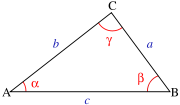
Mollweide's formula
Encyclopedia

In trigonometry
Trigonometry
Trigonometry is a branch of mathematics that studies triangles and the relationships between their sides and the angles between these sides. Trigonometry defines the trigonometric functions, which describe those relationships and have applicability to cyclical phenomena, such as waves...
, Mollweide's formula, sometimes referred to in older texts as Mollweide's equations, named after Karl Mollweide
Karl Mollweide
Karl Mollweide was a mathematician.He was born and brought up in Wolfenbüttel about 15 km south of Brunswick . Unlike most people who become leading mathematicians, Mollweide showed no interest in or talent for the subject while in elementary school...
, is a set of two relationships between sides and angles in a triangle. It can be used to check solutions of triangles
Solution of triangles
In trigonometry, to solve a triangle is to find the three angles and the lengths of the three sides of the triangle when given some, but not all of that information...
.
Let a, b, and c be the lengths of the three sides of a triangle.
Let α, β, and γ be the measures of the angles opposite those three sides respectively. Mollweide's formula states that
and
Each of these identities uses all six parts of the triangle—the three angles and the lengths of the three sides.
See also
- Law of sinesLaw of sinesIn trigonometry, the law of sines is an equation relating the lengths of the sides of an arbitrary triangle to the sines of its angles...
- Law of cosinesLaw of cosinesIn trigonometry, the law of cosines relates the lengths of the sides of a plane triangle to the cosine of one of its angles. Using notation as in Fig...
- Law of tangentsLaw of tangentsIn trigonometry, the law of tangents is a statement about the relationship between the tangents of two angles of a triangle and the lengths of the opposite sides....
- Law of cotangentsLaw of cotangentsIn trigonometry, the law of cotangents relates the radius of the inscribed circle of a triangle to its sides and angles.When a, b, and c are the lengths of the three sides of the triangle, and α, β, and γ are the angles opposite those three respective sides...



